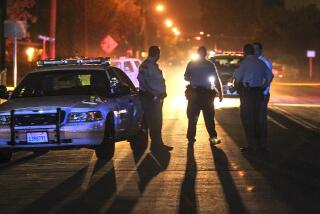Holding Parents Responsible
- Share via
In response to “How Many Parents Can We Prosecute?” (by Samuel H. Pillsbury, Op-Ed Page, May 10) regarding the arrest of the Southwest Los Angeles mother for allowing (and by her conduct encouraging) her son to engage in gang activities, Prof. Pillsbury’s intentions may be commendable from an academician’s point of view but that ignores the reality of what is occurring on the streets of Los Angeles today.
In this instance, the police did not merely drive by the residence of this parent and decide that she was contributing to the delinquency of a minor. A youth positively identified the leader of the gang. The subsequent investigation linked the gang leader to the residence in question.
Upon obtaining and serving a search-and-arrest warrant for that person, it was observed that the walls inside of the residence contained gang graffiti. Additionally, albums were found replete with photographs of gang parties, gang members in gang attire “throwing” their hand signs, and gang members with hoods concealing their identity. The album also contained pictures of the parent at the same party.
Gang members are not young innocent, naive, teen-age offsprings who simply need a nudge in the right direction to become honor students and model citizens. They are heartless, vicious, cold-blooded young people with no concern for human life. They use violence to perpetuate their gang life style. And, in this particular case, that type of behavior was not only condoned but actually encouraged by the parent.
Therefore, it was at my specific direction that the information be assembled and presented to the city attorney for appropriate criminal filing.
It is a fundamental obligation of a youngster’s parents to teach basic concepts of right and wrong, and to provide moral leadership. Often, this does not occur, and where a void exists in this primary instruction, a novel approach may result. Such is the case with the Los Angeles Police Department’s nationwide model DARE program, where police officers go into the schools to teach young people to just say no to drug use.
However, the basic responsibility for preventing teen-age lawlessness rests with the parents, and when they ignore or refuse to acknowledge this responsibility, they must accept the consequences of their inaction. And where we find their neglect is blatantly intentional or their actions show they condone or permit this gang involvement, they subject themselves to arrest and prosecution.
I agree with Prof. Pillsbury that the purpose of imprisonment for crime is punishment.
Unfortunately, our society has been too timid and too uninvolved to insist on punishing our lawbreakers, so we now have to live with gangs, drugs and neighborhood fear. If punishing one parent for contributing to the problems we all suffer seems harsh or unnecessary, perhaps our priorities are misplaced. For me, I hope it is just the beginning.
And Prof. Pillsbury, there is an answer to the headline on your column, “How Many Parents Can We Prosecute?” The answer is as many as necessary who openly and irresponsibly support the involvement of their children in gang activities.
LT. NICK BAKAY
Commanding Officer
Southwest Detective Division
LAPD
More to Read
Sign up for Essential California
The most important California stories and recommendations in your inbox every morning.
You may occasionally receive promotional content from the Los Angeles Times.












